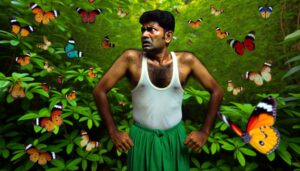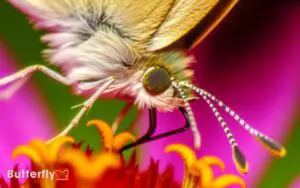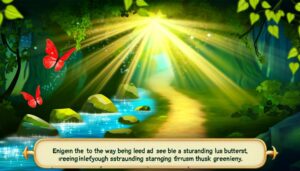How Do Butterflies Discover Winter Secrets?
Butterflies survive winter through diverse strategies such as migration, diapause, and hibernation. Monarch butterflies famously migrate up to 3,000 miles to Mexico, guided by environmental cues like temperature and daylight changes.
Others, like the Mourning Cloak, enter a state of diapause, slowing metabolic rates and producing antifreeze proteins to survive freezing temperatures. Sheltering in microhabitats such as tree bark and leaf litter provides additional protection.
Each species employs unique mechanisms to endure harsh conditions, influenced by physiological, environmental, and behavioral factors. For an in-depth understanding of these intricate adaptations and their evolutionary significance, continue the exploration.
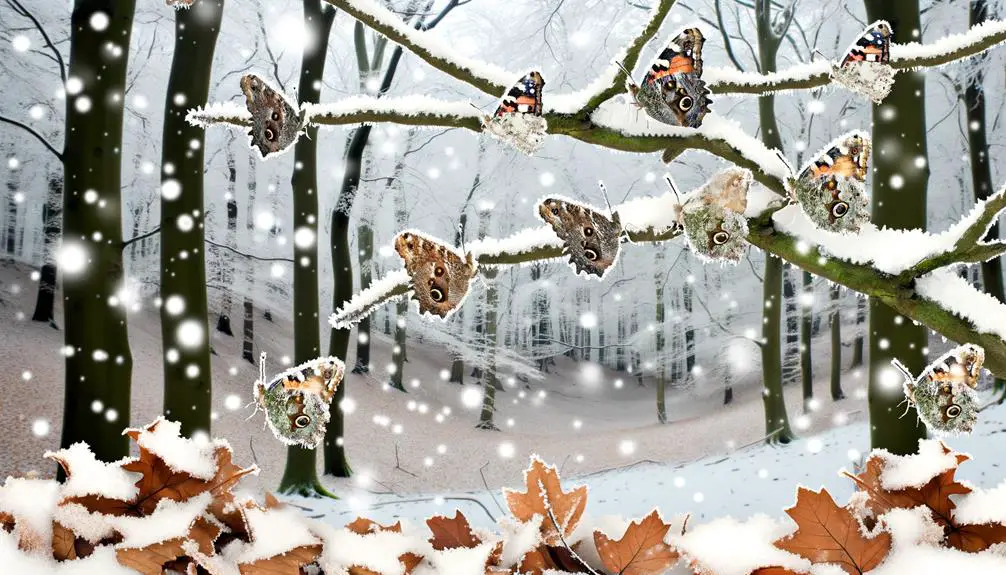
Key Takeaways
- Many butterflies enter diapause, a dormancy state, to conserve energy and survive the winter.
- Monarch butterflies migrate up to 3,000 miles to central Mexico to escape winter conditions.
- Some species, like the Mourning Cloak, hibernate in sheltered locations, reducing their metabolic rates.
- Butterflies utilize microhabitats like tree bark crevices and dense foliage to protect themselves from harsh weather.
Migration Patterns
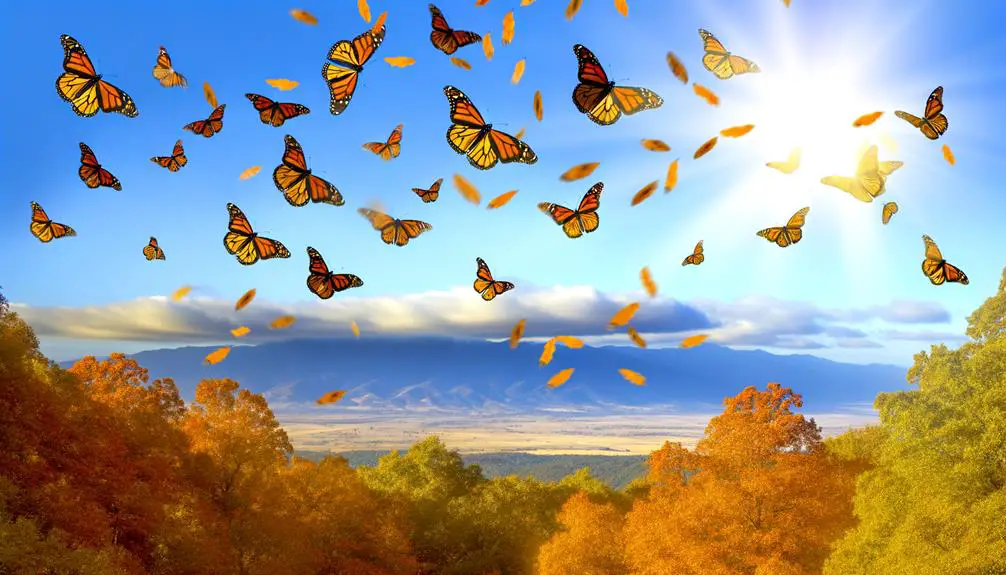
Migration patterns of butterflies during winter are characterized by long-distance travel from temperate regions to more hospitable climates, often involving highly coordinated, multi-generational journeys.
Monarch butterflies (Danaus plexippus) demonstrate notable migratory behavior, traveling up to 3,000 miles from North America to central Mexico.
These migration events are complex, relying on environmental cues such as temperature and daylight length.
The navigational mechanisms involve the use of a sun compass and magnetic fields.
Observations indicate that successive generations complete the round trip, with offspring instinctively resuming the journey of their predecessors.
This cyclical migration guarantees survival through avoidance of lethal winter conditions in temperate zones, highlighting an intricate interplay between biological instinct and environmental adaptation.
Diapause Explained
Diapause is a physiological state of arrested development that enables butterflies to survive unfavorable winter conditions.
This dormancy is primarily regulated by environmental triggers such as temperature fluctuations and photoperiod changes, which signal the insects to initiate metabolic suppression.
Understanding the mechanism and triggers of diapause provides critical insights into the adaptive strategies of butterflies during seasonal shifts.
Dormant State Mechanism
During the colder months, many butterfly species enter a state of suspended development, known scientifically as diapause, to survive unfavorable environmental conditions.
Diapause is a hormonally regulated process that can occur at various life stages: egg, larva, pupa, or adult. This dormancy involves metabolic suppression, where physiological activities such as feeding, growth, and reproduction are markedly reduced. The cessation of these activities is critical for conserving energy and resources.
Specific endocrine signals, particularly involving the juvenile hormone, orchestrate the initiation and maintenance of diapause. Morphological changes, such as thickened cuticles and increased antifreeze proteins, further enhance survival.
Understanding diapause mechanisms provides insights into insect adaptability and informs conservation strategies under changing climatic conditions.
Environmental Triggers Impact
The initiation and maintenance of diapause in butterflies are intricately influenced by environmental triggers such as photoperiod, temperature, and humidity, which signal the impending onset of unfavorable conditions.
These factors are pivotal in determining the physiological state of the butterfly, ensuring survival through adverse periods.
Key environmental triggers include:
- Photoperiod: Changes in day length influence hormonal pathways that initiate diapause.
- Temperature: Lower temperatures slow metabolic rates, aiding in energy conservation.
- Humidity: Variations can impact water loss and stress responses.
- Food Availability: Decline in resources can trigger diapause to conserve energy.
This methodical analysis demonstrates how butterflies adaptively manage their life cycles in response to environmental changes.
Hibernation Habits
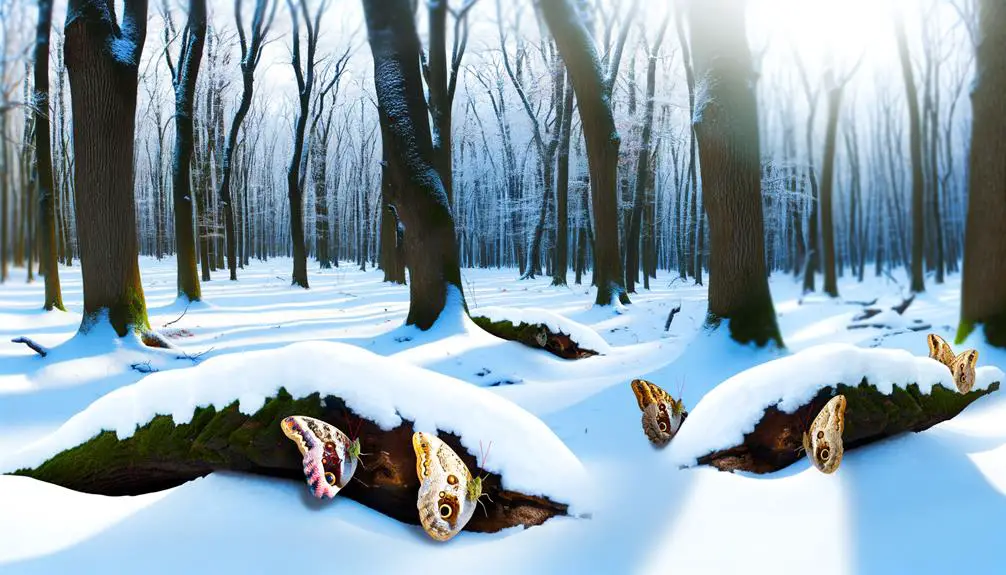
Hibernation habits in butterflies encompass two primary strategies: diapause in the chrysalis stage and overwintering in the adult form.
In diapause, the developmental process is halted within the chrysalis to conserve energy during adverse conditions.
Conversely, some species such as the Mourning Cloak, enter a state of torpor as adults, utilizing sheltered environments to endure the winter months.
Diapause in Chrysalis Stage
In the chrysalis stage, many butterfly species enter a state of diapause, a physiological dormancy that allows them to survive adverse winter conditions.
During diapause, metabolic activities notably decrease, conserving energy until favorable environmental conditions return. This state is induced by environmental cues such as:
- Temperature: A drop in temperature signals the onset of diapause.
- Photoperiod: Shorter daylight durations trigger hormonal changes.
- Humidity: Low humidity levels can influence diapause initiation.
- Nutrient Availability: Limited resources may induce diapause as a survival strategy.
These elements collectively guarantee the chrysalis remains viable throughout winter, emerging as an adult butterfly when spring arrives.
This complex adaptive mechanism highlights the intricate relationship between an organism and its environment.
Overwintering in Adult Form
Numerous butterfly species employ hibernation strategies to endure the harsh winter months in their adult form. This overwintering behavior, known as diapause, involves physiological changes that reduce metabolic rates, conserving energy.
Species such as the Mourning Cloak (Nymphalis antiopa) and Comma (Polygonia c-album) seek sheltered habitats like tree cavities, leaf litter, and man-made structures. These microhabitats provide protection from cold temperatures and predators.
Observations indicate that hibernating butterflies enter a state of torpor, where bodily functions slow down considerably. Glycogen reserves and antifreeze proteins in their hemolymph prevent ice formation within tissues.
This adaptive strategy facilitates survival during periods of food scarcity and harsh climatic conditions, ensuring their re-emergence in spring for reproduction and continuation of the species.
Sheltering Strategies
Butterflies employ a variety of sophisticated sheltering strategies to survive the harsh conditions of winter. These strategies are critical for minimizing energy expenditure and avoiding predation.
Detailed observations reveal several key methods:
- Microhabitat Selection: Butterflies often choose sheltered microhabitats such as tree bark crevices or dense foliage, which provide insulation and protection.
- Leaf Litter Utilization: Many species burrow into leaf litter, leveraging the insulating properties of decomposing organic material.
- Rock Crevices: Some butterflies find refuge in rock crevices, which offer stable microclimates.
- Man-made Structures: Utilization of human-made structures, such as sheds and barns, has been documented.
These strategies collectively enhance the likelihood of winter survival, ensuring the continuation of their lifecycle.
Species-Specific Tactics
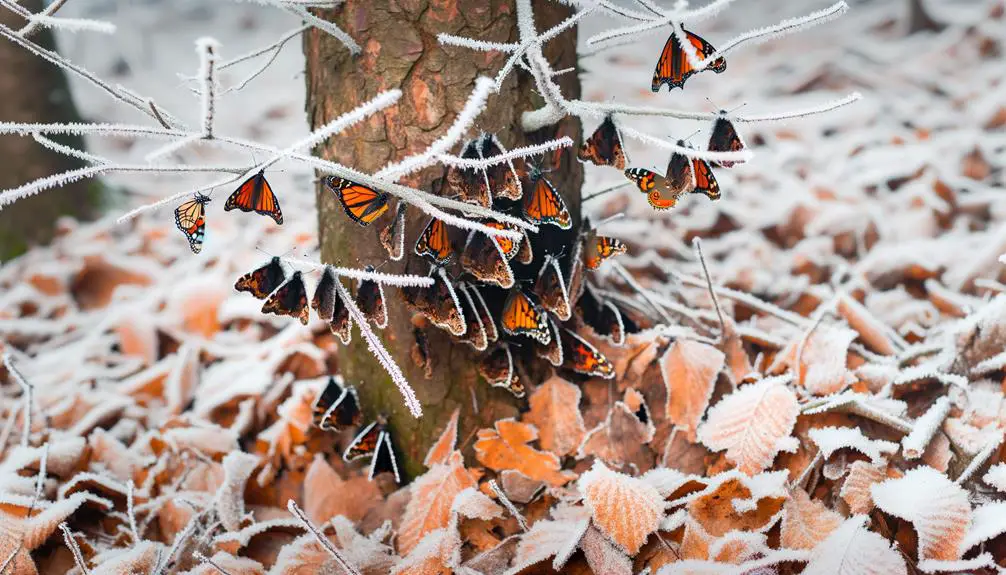
Among the myriad of sheltering strategies, specific butterfly species exhibit unique tactics tailored to their physiological and ecological requirements. For instance, the Monarch butterfly (Danaus plexippus) migrates to warmer climates, while the Mourning Cloak (Nymphalis antiopa) utilizes diapause, a state of suspended development, to survive freezing temperatures. Each species' tactics are influenced by factors such as metabolic rates and habitat preferences.
| Species | Winter Tactic |
|---|---|
| Monarch Butterfly | Migration to Mexico |
| Mourning Cloak | Diapause in tree crevices |
| Painted Lady | Migration to southwestern U.S. |
| Red Admiral | Hibernation in sheltered locations |
These specific adaptations guarantee survival during winter, showcasing the diversity in overwintering mechanisms among butterflies.
Climate Influences
Understanding the overwintering strategies of butterflies necessitates examining the impact of climate on their survival mechanisms. Variations in temperature, humidity, and seasonal changes greatly influence their physiological and behavioral responses. Analyzing these climatic factors reveals essential insights into how butterflies cope with winter challenges. Some species enter diapause, a state of suspended development, while others migrate to warmer regions to enhance their chances of survival. Proper butterfly care in winter involves creating suitable habitats that provide shelter and food sources, ensuring their populations remain stable despite harsh conditions. Studying these adaptations helps conservationists develop strategies to support butterfly populations amid changing climates.
Key climatic influences include:
- Temperature Fluctuations: Affects metabolic rates and energy reserves.
- Humidity Levels: Vital for preventing desiccation during overwintering.
- Seasonal Length: Determines the duration of diapause or migration.
- Snow Cover: Provides insulation but also affects habitat accessibility.
Understanding these elements is essential for predicting butterfly population dynamics and implementing conservation strategies in the face of climate change.
Survival Adaptations
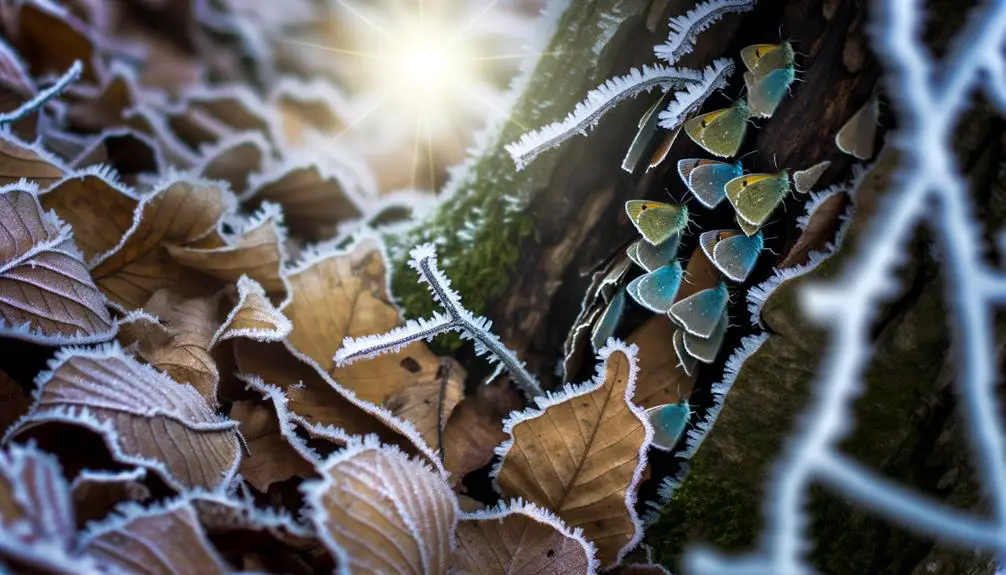
To endure the harsh conditions of winter, butterflies employ a variety of physiological and behavioral adaptations that mitigate the impact of low temperatures and scarce resources. These adaptations include diapause, migration, and biochemical changes. Diapause involves a period of suspended development, enabling butterflies to survive without food. Migration to warmer climates guarantees access to resources and suitable habitats. Biochemical strategies, such as the accumulation of cryoprotectants, protect cellular structures from freezing damage. Each adaptation is vital for survival during adverse conditions.
| Adaptation | Description |
|---|---|
| Diapause | Suspended development to survive resource scarcity |
| Migration | Movement to warmer climates for survival |
| Cryoprotectants | Biochemicals that prevent cellular freezing |
| Behavioral Changes | Shelter seeking to reduce exposure to elements |
These survival strategies exemplify butterflies' remarkable resilience.
Role of Host Plants
Host plants play a significant role in the life cycle of butterflies, providing essential nutrients and habitats for egg-laying, larval development, and adult sustenance.
During winter, the interaction between butterflies and host plants becomes even more important. Specific host plants offer refuge and resources that cater to overwintering strategies. These plants facilitate diapause, a state of suspended development in larvae or pupae, ensuring survival through adverse conditions.
Scientific observations reveal that host plants impact butterfly populations by:
- Offering thermal insulation during cold months.
- Providing food resources when other vegetation is scarce.
- Supporting microhabitats that reduce predation risks.
- Influencing the timing and success of diapause.
Understanding these interactions is essential for conservation efforts and ecological studies.
Human Impact
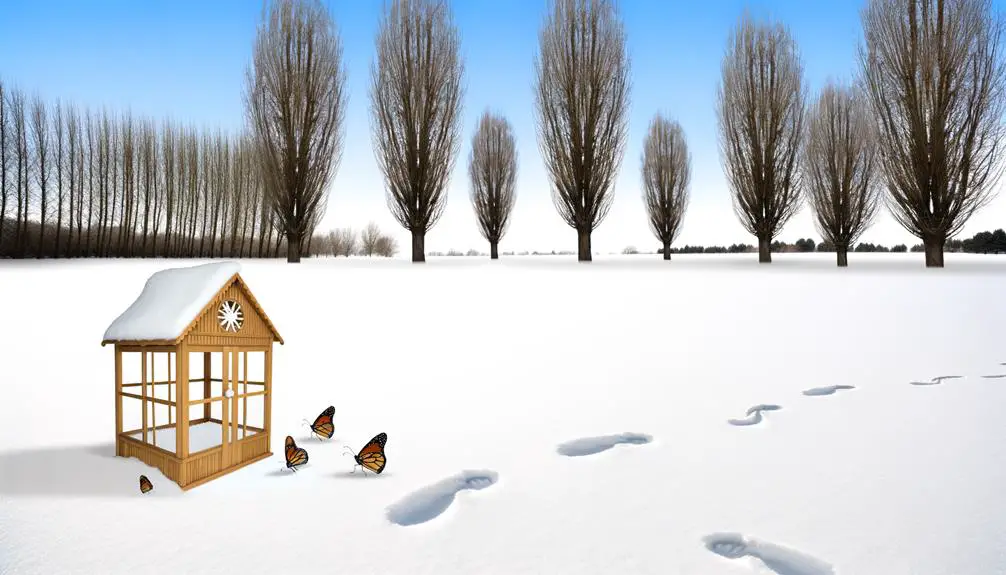
Human activities profoundly influence butterfly populations by altering habitats, introducing pollutants, and changing climatic conditions.
Urbanization and deforestation reduce the availability of vital overwintering sites, thereby disrupting migratory patterns and breeding grounds.
Agricultural practices contribute to habitat fragmentation and pesticide exposure, which adversely affect larval and adult stages alike.
Additionally, pollutants such as heavy metals and hydrocarbons can accumulate in host plants, leading to toxic effects on butterflies.
Climate change exacerbates these challenges by shifting temperature and precipitation patterns, which can misalign the phenology of butterflies with their host plants.
Consequently, these anthropogenic pressures necessitate targeted conservation strategies to mitigate negative impacts and guarantee the survival of butterfly species through winter and beyond.
Conclusion
In the intricate dance of survival, butterflies employ a symphony of strategies—migration, diapause, hibernation, and sheltering. These mechanisms, deeply intertwined with climatic variables and host plant availability, underscore the resilience and adaptability of lepidopteran species.
Human influences further complicate this delicate balance, necessitating a nuanced understanding of their ecological roles. Such knowledge illuminates the fragile threads that sustain biodiversity, emphasizing the paramount importance of conservation efforts to preserve these ephemeral yet crucial components of the natural world.

